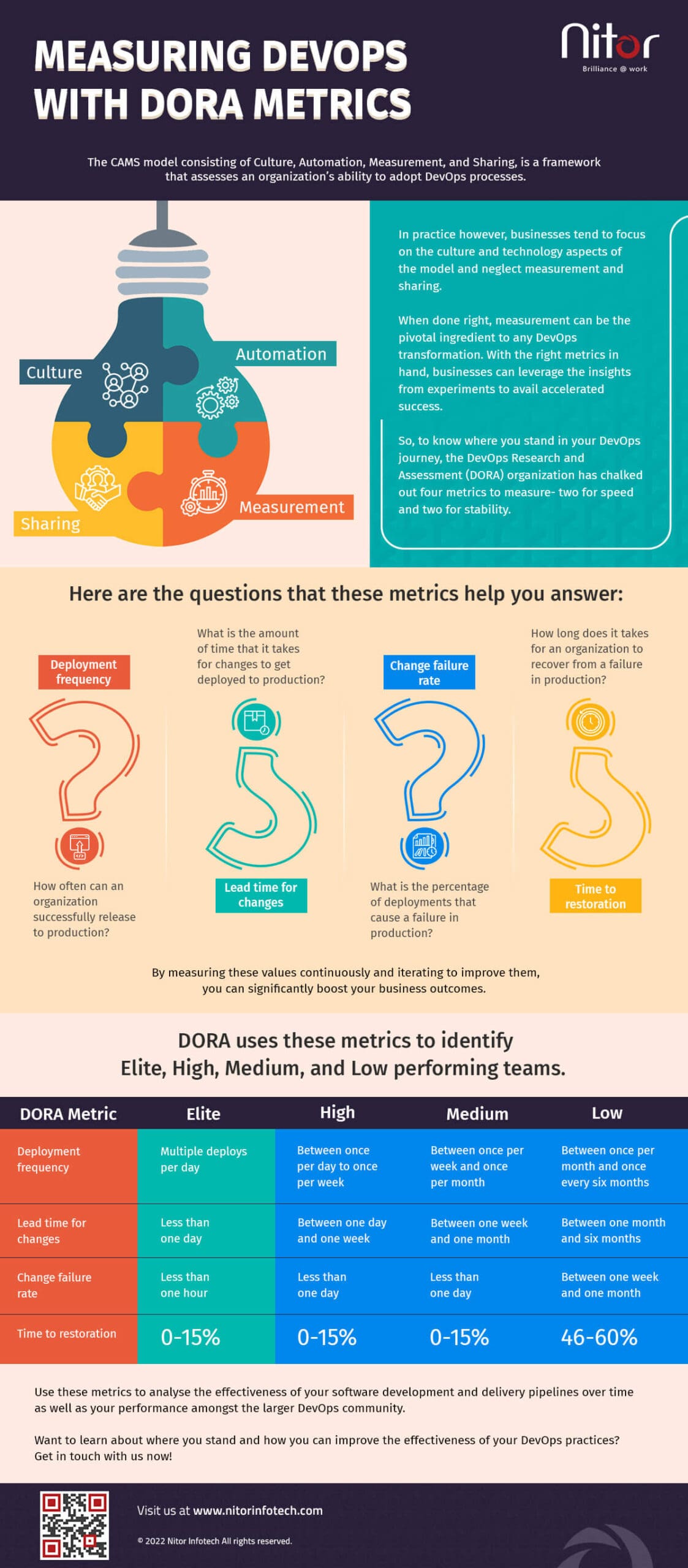Cloud and DevOps | 15 Jun 2022 | 8 min
Measuring DevOps with DORA Metrics

So, team, are we moving in the right direction?
This million-dollar question has rattled businesses that strategically invest in DevOps to bring about collaboration between the development and the operations teams. To address this question, most organizations conduct periodic meetings wherein the main goal is to discuss various key performance indicators (KPIs) and see if everything is in order.
But they tend to get stuck on one thing- how do we track our progress?
The quick answer is that you measure your DevOps progress with the help of a framework known as DORA metrics. Read on to find out what it is, where it came from, and why we need it.
Podcasters Damon Edwards and John Willis presented the CAMS (Culture, Automation, Measurement, and Sharing) model for DevOps, which is, put simply, a framework that assesses an organization’s ability to adopt DevOps processes.
While the CAMS model gave a comprehensive idea about an organization’s readiness to adopt DevOps and set standard values to inculcate DevOps culture, it was found that in practice businesses typically focused only on the culture and technology aspects of the model and often neglected measurement and sharing. This created an obvious obstacle in the process of measuring DevOps progress and denied organizations with the right data to make and iterate strategic decisions.
Now, it is crucial to understand that when done right, measurement can be a make-or-break ingredient to any DevOps transformation. Measuring your DevOps readiness equips you with the right metrics to turn your insights into pivotal business decisions and in turn, fast track your success.
So, to overcome the drawbacks of the CAMS model and better understand where you stand in your DevOps journey, the DevOps Research and Assessment (DORA) organization jotted down four metrics that you can measure:
1. Deployment Frequency (DF)
Deployment frequency speaks about the cadence in which an organization successfully releases ideas to production. With it, you can measure metrics like the frequency with which code is deployed or how often it is released to customers.
2. Mean Lead Time for Changes (MLT)
Mean lead time for changes is a metric that gives you insights on how long it takes a team to get the committed code to production. It helps analyze the health of the cycle time and gauge whether the team would be able to deal with a sudden influx of requests.
3. Mean Time To Recover (MTTR)
Mean time to recover delves into how long it takes to restore service after an unplanned outage. Ideally, a lower mean time to recover bodes well and can be easily achieved with the help of robust delivery practices and active monitoring.
4. Change Failure Rate (CFR)
Change failure rate sheds light on the frequency with which changes such as roadblocks, quick-fix incidents, failed deployments, etc. lead to failures in production. This metric helps in efficient resource allocation by keeping track of how much developer time is diverted to activities with negligible business value.
At a high level, you can see that the first two metrics measure speed while the latter one’s measure stability. So, by measuring these values continuously and iterating to improve them, you can significantly boost your business outcomes.
With the help of DORA metrics, you can identify Elite, High, Medium, and Low performing teams in your organization and modify business processes to maximize productive output.
Studies show that elite teams are able to achieve the following:
If I haven’t convinced you by now to explore the DORA metrics, let me shed light on how they have the ability to empower your team with proper direction.
DORA metrics have proven to be a great starting point to analyze your current delivery levels as well as equip you with the standard data to see how you compare to your peers. By tracking DORA metrics over time, you can make informed decisions about what needs to be changed and how to deploy those changes without disturbing productivity.
With DORA, you can aim to achieve elite status for your team by ensuring inclusivity, equity, and peer review. Once you invest in building elite teams, you will be able to impart an enhanced stakeholder experience and achieve a plethora of benefits such as:
Here’s an interesting infographic that summarizes the DORA metrics for your perusal.

Read our case study on DevOps implementation for a software company and reach out to us to learn more about out Cloud and DevOps services.

we'll keep you in the loop with everything that's trending in the tech world.
